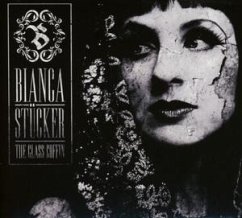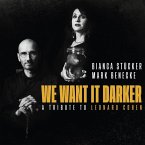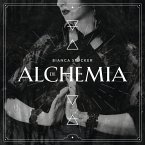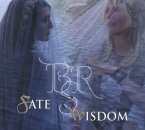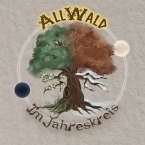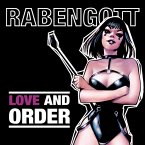"70 percent synthetics, 20 percent harpsichord and 10 percent dulcimer - this adds up to cool electronic dulcimered darkpop. Presented by a smart and beautiful gothic lady - what more could I ever ask for?" - Mark Benecke, Germany's resident TV goth pathologist de luxe This is, in a nutshell, what the first Bianca Stücker album is all about. Or rather, the first solo album the talented musician releases under her own name. She is an artist of many different talents and has also made herself a name as a writer with several published novels and a string of witty magazine columns, while running her own studio for providing artful tattoos and teaching oriental dance and tribal fusion. Since 1999, she has realised her own musical ideas with a number of different projects. Her bands were called The Violet Steam Experience, Ensemble Violetta or The Violet Tribe and often infused their dark pop with medieval or renaissance music elements, owing strongly to the fact that Stücker is a fully-fledged church musician with a PhD in musicology. Apart from her fascination with music from the past, Stücker has also a strong penchant for electronic sounds, an avenue she last explored 2007 with her VaNi project. With The Glass Coffin, synths and beats come to the fore once more. There is still a faint renaissance influence to be felt in some of the harmonies, and acoustic elements such as hammered dulcimer and harpsichord shape the overall atmosphere with their distinctive sound. But the first bars of the opening track, "The Other Me", already show where we are heading this time: throbbing, surging rhythms intertwine with synthetic melodies, thus forming an ideal base for Stücker's enchanting voice, changing from cool and powerful to dreamy and meditative, bringing every line to life in the most hypnotic way. A huge influence on The Glass Coffin was Stücker's fascination with alchemy and tarot, which also shows in the beautiful artwork of the album. Every song has its own tarot motto card, underlining or enhancing the theme of the song with its individual symbolism. For instance, the heavy instrumental track "Automat" corresponds to "The Tower", symbolising a destructive element but also the strength to break from chains, while the wistful title track is combined with "The Moon". Bianca Stücker played all the instruments herself and also did her own arrangements and recording. To her delight, she became acquainted with renowned producer Winus Rilinger (The Eternal Afflict) while still working on the new album, and he happily agreed to take over the production and mixing, also adding some synth sounds. Stücker herself describes her songs as "a cosmos of kitsch and sweet horrification". And indeed, behind the enchantingly beautiful melodies and shimmering surfaces often looms an abyss. The morbid tango of "La Pascualita" for instance was inspired by the rather gruesome story that is told of a mannequin in a bridal shop in Mexico: the owner's daughter died 75 years go on her wedding day from a spider's bite. A few days later, a new mannequin appeared in the shop, bearing a striking resemblance with the deceased. It still can be seen in the shop today - and only the descendants of the owners are allowed to change its clothes ... Kirsten Borchardt "70% Synthetik, 20% Cembalo und 10% Hackbrett, das ergibt lässigen Elektro-Hackbrett-Finsterpop. Dargeboten wird es von einer klugen und schönen Grufti-Frau ... was will ich mehr?" - Mark Benecke Damit hat der coolste Doktor aller Zeiten schon perfekt zusammengefasst, was es mit dem ersten Album von Bianca Stücker auf sich hat. Oder vielmehr, dem ersten Soloalbum, das die talentierte Renaissance-Frau unter eigenem Namen veröffentlicht. Denn, nebenbei bemerkt, Stücker macht nicht nur Musik, sondern schreibt schräge Romane und pointierte Kolumnen, tätowiert und lehrt in ihrem eigenen Tanzstudio Orientalischen Tanz und Tribal Fusion. The Glass Coffin folgt auf eine ganze Reihe von Projekten, in denen sie schon seit 1999 ihre musikalischen Visionen realisiert hat. Ihre Bands tragen Namen wie The Violet Steam Experience, Ensemble Violetta oder The Violet Tribe und speisen ihren dunklen Pop gern mehr oder weniger stark aus mittelalterlichen Klängen oder Renaissance-Musik - Stile, zu denen die Sängerin als ausgebildete Kirchenmusikerin und promovierte Musikwissenschaftlerin eine besondere Beziehung hat. Ihre andere musikalische Vorliebe, die sie zuletzt 2007 mit dem Projekt VaNi auslebte, galt schon immer elektronischen Sounds. Und die kommen auf The Glass Coffin wieder einmal verstärkt zum Zug. Zwar sind die Renaissance-Anleihen bei einigen Harmonien noch spürbar, und akustische Elemente wie Cembalo und Hackbrett spielen nach wie vor eine Rolle, aber schon die ersten Takte des Openers "The Other Me" machen klar, wohin die Reise diesmal geht: Pulsierende, tanzbare Rhythmen verbinden sich mit synthetischen Melodien und formen ein ideales Gerüst für Stückers betörend schöne Stimme, die mit Leichtigkeit den Ausdruck wechselt, mal kraftvoll-kühl und mal versponnen klingt und jede Zeile auf hypnotische Weise lebendig werden lässt. Einen großen Einfluss auf The Glass Coffin hatten Alchimie und Tarot, für die Stücker - wie unschwer auch am Artwork des Albums zu erkennen ist - ein großes Faible hat. Jedem Song wurde eine Karte zugeordnet, die durch ihre Symbolik das Thema des Songs aufgreift oder verstärkt. So gehört zu dem harten Instrumental "Automat" die Tarotkarte "Der Turm" mit seiner zerstörerischen Kraft, die jedoch auch Fesseln sprengen kann, während "Der Mond" den eher sehnsuchtsvollen Titeltrack begleitet. Bianca Stücker spielte alle Instrumente selbst ein und schrieb die Arrangements. Sie freute sich sehr, dass sich während der Aufnahmen der Kontakt zu dem renommierten Produzenten Winus Rilinger (The Eternal Afflict) entwickelte, der daraufhin die Produktion begleitete und noch einige Synthisounds beisteuerte. Sie selbst bezeichnet ihre Songs als "Kosmos aus Kitsch und Schauerlichkeit" - und tatsächlich tut sich hinter den oberflächlich oft betörend schönen Melodien und glitzernden Oberflächen oft genug ein Abgrund auf. Wie beispielsweise bei "La Pascualita", dessen morbider Tango von der gruseligen Geschichte inspiriert wurde, die man sich von einer Schaufensterpuppe in einem Brautmodengeschäft in Mexiko erzählt: Die Tochter der Inhaberin starb vor 75 Jahren an ihrem Hochzeitstag an einem Spinnenbiss. Wenig später tauchte eine Puppe im Laden auf, die eine frappierende Ähnlichkeit mit der Verstorbenen hat und dort bis heute steht - und immer nur von den Besitzern neu angezogen wird ...
| CD | |||
| 1 | The other me | 00:04:38 | |
| 2 | In the midst of life | 00:05:04 | |
| 3 | Something to remember | 00:04:18 | |
| 4 | Automat | 00:04:04 | |
| 5 | The glasss coffin | 00:05:35 | |
| 6 | In the parlor | 00:04:31 | |
| 7 | La pascualita | 00:05:57 | |
| 8 | The thief | 00:05:15 | |
| 9 | Temperance | 00:04:42 | |
| 10 | Sparks of bliss | 00:04:48 | |
| 11 | Shine your light on me | 00:04:23 | |
| 12 | Underneath the fading twilight | 00:05:38 | |
| 13 | Ephemerality | 00:03:38 | |

